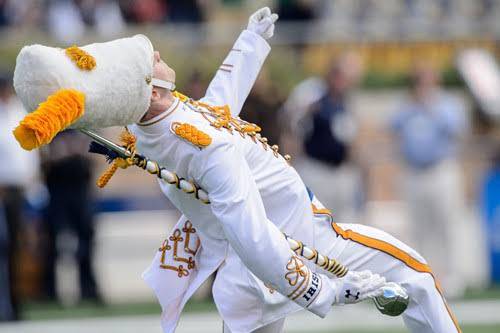The air on the campus of the University of Notre Dame, perpetually thick with the echoes of tradition and the murmur of anticipation for Saturday afternoons, now carries a note of solemn remembrance. The university is commemorating the life and indelible legacy of H. Lee Hope, unequivocally the most renowned marching band director in the school’s storied history. Hope, who served as the Director of Bands from 1968 to 1999, was more than just a conductor; he was an architect of atmosphere, a guardian of tradition, and a beloved figure who shaped the Notre Dame experience for generations of students, alumni, and fans.
H. Lee Hope’s tenure at Notre Dame spanned three decades, a remarkable period of consistency and evolution for the Band of the Fighting Irish. When he arrived in 1968, he inherited a program with a proud past but one he would elevate to unprecedented heights of national recognition and musical excellence. He wasn’t merely content with maintaining the status quo; he aimed for perfection, not just in musicality but in presentation, precision, and the overall spirit of the band.
Under Hope’s meticulous direction, the Notre Dame Marching Band became synonymous with precision drill, vibrant sound, and a captivating on-field presence that few, if any, could rival. He instilled a discipline and dedication in his students that extended beyond the practice field, fostering a sense of camaraderie and shared purpose that endured long after their days in the blue and gold uniform. His demands were high, but his respect for his students was immeasurable, and it was this mutual understanding that forged such a powerful and successful program.
One of Hope’s most enduring legacies is undoubtedly the refinement and popularization of the band’s distinctive style. He emphasized crisp, military-style marching, clean formations, and a powerful, resonant sound that perfectly complemented the grandeur of Notre Dame Stadium. The sight of the band taking the field, in their iconic uniforms, marching with unwavering precision, to the stirring strains of “Notre Dame Victory March” or a meticulously arranged medley, became an integral part of the game-day ritual. For many, the band’s performance was as anticipated as kickoff itself, a testament to Hope’s showmanship and musical artistry.
Hope was also an innovator. While deeply respectful of Notre Dame’s rich traditions, he wasn’t afraid to introduce new elements or modernize arrangements to keep the band fresh and engaging. He expanded the band’s repertoire, challenging his musicians with complex pieces while always ensuring that the essence of the Notre Dame sound remained intact. His attention to detail was legendary; every note, every step, every formation was scrutinized and perfected under his watchful eye. Students often recount stories of his demanding rehearsals, but invariably follow them with anecdotes of the profound sense of accomplishment and pride they felt when their hard work culminated in a flawless performance.
Beyond the technical aspects, H. Lee Hope understood the profound emotional connection that the marching band had with the University and its fanbase. He recognized that the band was the heartbeat of the game-day experience, a living embodiment of the Notre Dame spirit. He fostered an environment where the band members understood their role as ambassadors of the University, recognizing that their performances were not just entertainment, but a vital link to the traditions and values of Notre Dame. He cultivated a sense of reverence for the institution, instilling in his students a deep appreciation for the history they were upholding with every performance.
His impact stretched far beyond the football field. Hope was a respected educator, a mentor to countless students, many of whom went on to successful careers in music education and beyond. He taught them not just about music, but about leadership, teamwork, perseverance, and the importance of striving for excellence in all endeavors. Alumni from his tenure often speak of the life lessons learned under his guidance, emphasizing that their time in the band under Hope shaped them as individuals as much as it did as musicians. He had a unique ability to connect with his students, to inspire them to reach their full potential, and to instill in them a lifelong love for music and for Notre Dame.
The sheer longevity of his tenure – 31 years – allowed him to oversee the band through numerous eras of Notre Dame football, including national championship seasons. He was a constant, familiar presence, a figure who represented stability and unwavering excellence amidst the cyclical nature of collegiate sports. His image, often seen conducting with passion and precision, became as iconic as the Golden Dome itself.
The tributes pouring in from former band members, colleagues, and Notre Dame faithful speak volumes about the depth of his impact. They recall not just his musical genius but his kind nature, his booming laugh, and his genuine care for each and every student. They speak of the chills they felt as they marched onto the field with him at the helm, the pride in representing Notre Dame, and the lasting bonds forged through shared experiences under his leadership.
As the University of Notre Dame commemorates the life of H. Lee Hope, it’s a moment to reflect on a remarkable career that transcended the confines of a band hall or a football field. He built a program, shaped lives, and defined an era for the Band of the Fighting Irish. His legacy will continue to resonate with every powerful drum beat, every soaring trumpet note, and every precise step taken by the band in Notre Dame Stadium. He was, without doubt, the most renowned marching band director in Notre Dame’s history, and his spirit will forever march on with the Fighting Irish. His life was a symphony of dedication, excellence, and unwavering devotion to Notre Dame.



